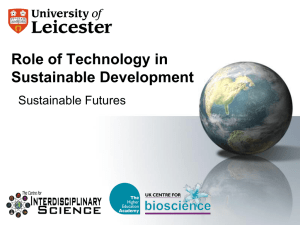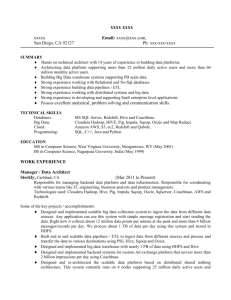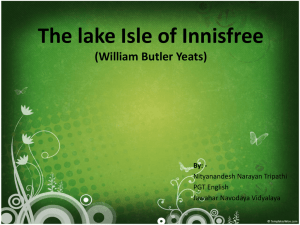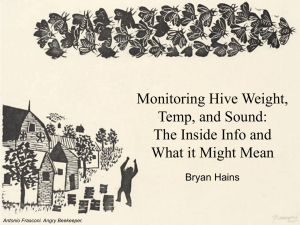What does it mean to “Work Open” in Hive NYC? (DRAFT).docx
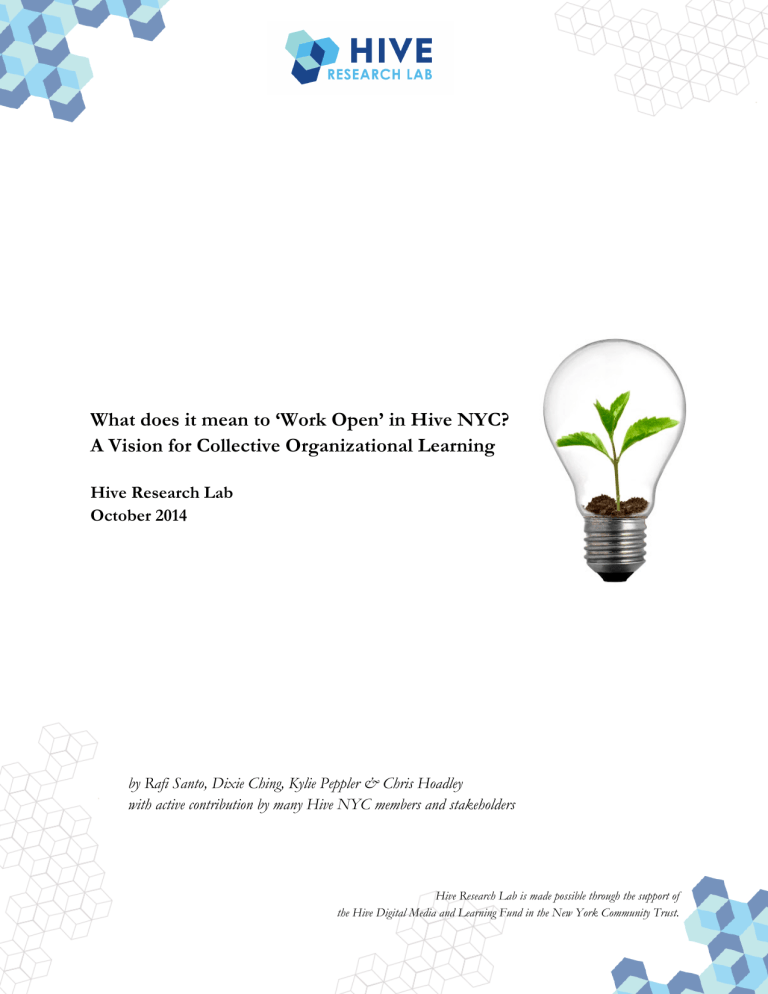
What does it mean to ‘Work Open’ in Hive NYC?
A Vision for Collective Organizational Learning
Hive Research Lab
October 2014
by Rafi Santo, Dixie Ching, Kylie Peppler & Chris Hoadley with active contribution by many Hive NYC members and stakeholders
Hive Research Lab is made possible through the support of the Hive Digital Media and Learning Fund in the New York Community Trust.
Table of Contents
I. Introduction – Why is Working Open relevant to Hive NYC? .......................................... 3
II. The Roots of ‘Working Open’ and its Place in Education ............................................... 3
III. Working Open in Action ................................................................................................. 4
1. Core practices of working open
2. What is shared in open work?
3. Open with whom? Issues of audience
4. Benefits of working open
IV. Central Tensions - The Pain Points of Open Work ........................................................ 7
1. Trust
2. Resources
3. Useful Sharing
4. Youth Safety
5. The 'Firehose' Effect
V. Conclusion - Hive NYC as a Collective Experiment in Open Work Culture ................... 8
VI. Resources on Working Open ........................................................................................... 9
VII. Process and Contributors .............................................................................................. 10
This work is licensed under a Creative Commons Attribution-ShareAlike 4.0 International License. http://creativecommons.org/licenses/by-sa/4.0/
2
I. Introduction – Why is Working Open relevant to Hive NYC?
As a learning network, Hive NYC is continually in the process of understanding what its potential is, what its purposes could be, and how organizations can achieve more together than they could apart. Within that, it’s imperative that we think about how we can be ‘a network that learns’ , a community that is continually generating , circulating and accumulating knowledge relevant to accomplishing our goals around serving youth in a connected world.
In the summer of 2014, a group of Hive NYC members and stakeholders came together to think about how the idea of ‘working open’ might play a role in addressing key knowledge management issues that members had expressed as important to them at the State of the Hive meeting in March 2014 . Issues such as locating expertise, capturing best practices and accumulating collective wisdom were central to these discussions. As a way of working that values collaboration, failing early and often, ongoing storytelling, community building and an experimental and flexible spirit, we believe that working open can be considered an important mode of engagement that allows Hive members to progress both individually and collectively.
However, it’s first critical to understand what’s meant b y this term and what it looks ke in practice. In this community white paper, synthesized from the perspectives of many Hive stakeholders, we outline the contours and tensions of what it might mean to work open in Hive NYC, aiming to provide a vision for collective organizational learning within the network.
II. The Roots of ‘Working Open’ and its Place in Education
Working Open can be understood as a set of cultural practices around work that have their roots in the Free/Open Source Software (F/OSS) community and, to a degree, approaches to human-centered and
‘agile’ design. The F/OSS movement at its heart has two touchstones: (1) non-proprietary software, which might be seen as the ‘what’ of F/OSS, and (2) peer production, the open collaborative process that is the
‘how’ of F/OSS. The first touchstone is based on the sharing and licensing of source code that is the heart of computer software in a way that allows anyone to can access it, see how it works, improve it and share it with others without limitation – what Richard Stallman, a critical figure in the F/OSS movement, called the “ four freedoms ”. The second, perhaps more relevant to our discussion here, centers on the proces s of ‘commons based peer production’, otherwise known as ‘open collaboration’ . These are the sorts of mass collaborative practices and associated communities (like Wikipedia, Linux, and many others) that allow people from around the world to easily contribute, coordinate action, and create something that no single actor could alone.
While it’s impossible to fully decouple the production of software from the idea of working open, part of what we might imagine ourselves doing here is lifting and adapting some of the practices found in the open source community and asking how they might be relevant to the way we work as a network of educators. Instead of peer production and open collaboration aimed at creating one piece of software, in Hive
Learning Networks we might ask how these practices might create a dynamic professional learning community, one where people are able to work smarter and come up with more resilient solutions to emergent problems together. As suggested by one Hive member during our Summer discussions, we can think about ‘ working open ’ as a potential pedagogical vision for the kind of intentional organizational ecosystems that educators operate in that allow them to effectively explore new areas of practice and learn from one another, be these areas explicitly related to technology or not. In essence, working open in Hives can be seen as collective learning and collaboration on the level of educational networks.
3
III. Working Open in Action
So what d o we actually mean when we say ‘working open’ , and why is it something we should care about? In this section, we move to concretize the notion of working open by addressing a number of core questions: (1)
What are the core practices associated with working open? (2) What gets shared and (3) with whom in this process? (4) What are the purported purposes and benefits of these practices?
1. The Core Practices of Working Open
Working Open has a range of practices associated with it, here we briefly outline the ones that emerged as central within our conversations. We also draw off of some writing by Matt Thompson of the Mozilla
Foundation who has written extensively about the subject. Generally, our driving orientation around what to include here were practices that helped address the challenge of creating a network that can effectively learn on a collective level.
I.
Rapid Prototyping ‘ in the wild ’ – part of ‘ openne ss’ is a commitment to quickly prototyping, testing out and iterating small ideas in real contexts before they go big, and then as they develop continually engaging in public testing as a means of getting feedback on and strengthening work.
This might be something as simple as gathering some co-workers around a table to engage in an activity or play with a prototype, or, on a larger scale, holding a one day workshop that pilots an idea before running a fullon program. It’s a commitment to both flexibility and learning in the face of how things actually play out in the real world. And the results of tests and pilots are not simply things that one organization can benefit from, linking them to the next practice related to documentation and public sharing means that others learn from your pilots.
II.
Public Storytelling, Reflection and Documentation – The role of documentation and reflection is central to open work, especially doing so in way that privileges both process as well as outcomes . As a project develops and pilots occur, recapping the work and reflecting on it publicly in places like forums, meet-ups and blogs serves to allow better iteration, but also serves a storytelling function that provides context for different stakeholders to understand, get involved in and give feedback on the work as it’s unfolding. Individuals that are centrally as well as peripherally involved are able to use such documentation as a basis for making sense of wha t’s happening in a project, learn from it, and potentially, contribute to it.
III.
Community Contribution – the processes of openly piloting work and engaging in sharing and reflection about it are part of larger effort towards building community around a project or idea and giving that community the opportunity to contribute to the project in unique ways. Contributions might be small, like asking people to give feedback on an idea via email or seeing if another organization can provide a space where you can test out an early prototype, or larger, like bringing someone in to actively build part of a tool or curriculum in a way that leverages their expertise.
Community building, of course, is already a commitment many Hive organizations hold. The view of working open emphasizes designing projects in ways that not only engage a range of stakeholders, but also build clear opportunities for these stakeholders to contribute to the development of a project.
IV.
Making the ‘Content’ of Work Accessible – working open emphasizes sharing work in progress, but also sharing outcomes of work in way that others can take up and build on. Going back to its
4
roots in open source software where the source code of a project remains accessible, similarly working open in educa tion values the development of ‘open educational resources’ that are remixable, transparent and extensible. On a legal level, this might mean using ‘copyleft’ licensing such as Creative Commons , Open Publication License and GNU General Public License . Outside that, it might mean thinking about how you can create resources that are more easily appropriated by others by privileging modularity and extensibility.
Each of these practices is mutually reinforced by the others, and in many ways practicing each individually doesn’t quite offer the potential benefits of the approach. Taken together and in concert with one another they might be seen as forming a holistic approach to the development of projects and programs within an open ecological context.
2. What is shared in open work?
A central question in working open is what, exactly, it is that’s getting shared. One way to think about this is the difference between sharing about work, and sharing the ‘work’ itself. This is a subtle distinction, but speaks to the points made earlier about sharing reflections on the one hand and making the ‘content’ of work accessible on the other.
Reflection and documentation along the way (formative) as well as reflections at a pr oject’s conclusion
(summative) are especially valuable to give insight into how things worked or didn’t, what course corrections were made, and what impacts were seen as the result of work done. Such sharing might include reflections on a program while it’ s being implemented, perspectives of students involved in a project, early prototypes or sketches, thought pieces or opinions, and the results of a pilot or experiment. It is through such documentation and reflection that organizations often identify best practices and lessons learned that might shape future activity and be leveraged by others in the ecosystem.
Sharing the work itself, be it a curriculum, digital tool, or youth-created artifacts serves linked but distinct purposes. Coupled with reflections and documentation, it allows others to clearly see what the ‘embodied’ work looks like in ways that are concrete -- what previously might have seemed abstract and unclear within documentation can become grounded when paired with actual objects of work. At the same time, sharing the work itself creates the conditions by which that work can be spread and adapted into new contexts, often a goal for many organizations.
Additionally, our conversations touched on the importance of “sharing with care”, that is , sharing in a way that actually makes work, especially in-progress work, accessible to various stakeholders. Being ‘open’ doesn’t simply mean suddenly adding every stakeholder to every planning document, google folder or scribbled notes.
Sharing must happen with intentionality and in a way that takes into account what context those of the receiving end have about a given project or the issues it’s linked to. Sharing should also happen in a way that makes clear to the audience how they can effectively engage with t he project. Clear contexts and ‘hooks’ for engagement allow sharing to be productive, as opposed to overwhelming.
5
3. Open with Whom? Issues of Audience
Just as sharing ‘everything’ makes little sense wh ile working open, sharing with ‘everyone’ is also counterproductive. What then, is the right way to think about who we’re sharing with when we work open?
How do we think about issues of audience and degrees of publicity?
Matt Thompson of Mozilla writes a bout the importance of knowing ‘ what gear of open’ you’re in, laying out four d ifferent levels: 0) closed, 1) ‘Not yet’, 2) Open and 3) ‘Shout it from the Rooftops’ . H e’s acknowledging here that at different stages a project might share in different ways, and that certain things are simply not sh ared. We’d add that at different points in a project, different audiences might be relevant to share with, or not.
Another way to think about audience is to think through different stakeholder groups that are relevant in different moments and in different ways. Naturally, our core project teams and collaborative partners have the most access to and context around the work as it unfolds. But beyond that, we can begin to think in interesting ways about different groups that we might be open with – this might mean broader teams within our own organizations, individuals external to the project that we know might be good to consult along the way, youth that we trust who might play a role in the design process itself, etc.
Within Hive, many contexts exist wher e sharing might occur with the community in a ‘semi public’ way, such as cohort and community calls, meet-ups, affinity groups and a variety of online sites such as etherpads, discourse and minigroup. Each might represent different audiences, and also differ in terms of ‘ephemerality’
– some sites of sharing might mean something is shared but isn’t recorded, others might be recorded but not broadly accessed, some sites might have distinctive affordances, perhaps including particular types of expertise in the room or providing opportunities to actually test prototypes (like pop-up events) as opposed to just sharing an aspect of a project.
When thinking about issues of audience, it’s critically important to be intentional about when, with whom, and for what purposes something gets shared. Organizations can very proactively put systems and plans in place from the beginning of a project so that open work doesn’t just become an afterthought, but part of a thoughtful strategy of engagement and community collaboration.
4. The Benefits of Open Work
In our discussions, working open was seen as beneficial by Hive members on a number of levels. We group them here into four categories: (1) Improved Projects , (2) Greater Efficiency (3) Increased
Discoverability , (4) A Stronger Commons .
I.
Improved Projects – most central in our discussions of the benefits of open work was simply that work turns out better when done openly. Testing, and failing, early and often means projects can get kinks out before they become big and bulky. Reflecting publicly means tighter feedback loops that leverage what others know and lead to better iteration. Engaging with your community regularly and having them actively contribute to the work means a greater likelihood of meeting needs through the
6
project that might not have been envisioned early on. Thus, the process of open work can lead to more flexible and agile projects that can better adapt to changing needs on the ground and are more attuned to the communities they serve.
II.
Greater Efficiency – Another strong theme concerned the greater efficiencies achieved through open wor k. Members spoke of the idea of ‘time neutrality’; that time put in during a project for documentation and reflection along the way was ultimately time saved later when reporting on grants and to boards as well as when bringing in new partners. Additionally, being on the receiving end of a community that works open also might mean that work is more effici ent because it doesn’t have to
‘recreate the wheel’ , since existing work and lessons learned, created either within your organization or externally, can be leveraged. Similarly, early prototyping could lead to projects that are less likely to spend sparse resources on retroactive project realignment later on.
III.
Increased Discoverability – engaging in work publicly can also lead to a greater likelihood of it being discovered by unexpected stakehold ers, allowing organizations to ‘find their tribe’, effectively
‘talk to other tribes’, and even clarify what ‘tribes’ exist in a larger ecosystem that might not be currently organized. In the context of Hive, this could also mean that potential collaborating organizations are less of a ‘black box’ - an organization that works open is fostering greater awareness of its capacities and interests to the broader Hive community.
IV.
A Stronger Commons – the sharing of practices, resources and lessons learned in an open way was also seen as a means to create a stronger common space that can elevate the whole Hive ecosystem.
People spoke of wo rking open as ‘paying it forward’ in Hive, ostensibly contributing to future projects in ways that might not be entirely predictable in the present. Through members that embody values and practices of working open, the shared communal space of Hive can better function as a collective learning ecosystem for organizations.
IV. Central Tensions - The Pain Points of Open Work
Working Open is not without its own challenges, complications and tensions. In this section we name a number of these tensions that emerged in the context of our discussions and that we have observed in our research. Many tensions we discuss may not be entirely unique to working open in Hive and the educational context it inhabits, but we do believe that they take on particular flavors when we think about them through this lens of working with youth. Understanding what’s different about working open in Hive and where the pain points are is critical to understanding not only how to effectively leverage it, but also to understand where we might aim to change and adapt this approach to the particularities of our work world in Hive NYC.
We focus here on five core tensions that we see as particularly salient to Hive: (1) Trust, (2) Resources, (3)
Useful Sharing, (4) Safety of Youth and (5) The ‘Firehose’ Effect.
1.
Trust - tensions concerning trust are naturally present when we think about sharing what we’re working on with others, especially those outside of our organizations. There are many dimensions to this tension. Often there is a need to trust that sharing something freely will not diminish the long term viability of a proj ect either because it’s not as ‘polished’ when it’s shared, or that in sharing it openly the ideas that drive it can be taken by others. Beyond those issues of reputation and property, trust issues point to the larger need for communities that are both generous and thoughtful in the ways they give feedback and contribute to projects.
7
2.
Resources - often organizations want to share their work with others and make it more public, but the resources they need to so might not be at hand. For many organizations, limited staff time means that engaging in working open practices can be at the bottom of a long list of things they’re juggling.
There’s also an important point that the ski lls needed to develop and implement projects are actually different from those needed to share. This raises a critical distinction difference between working open in an educational context and working open in open source communities. In the context of open source software, the content of the work done is code and so is easily shareable through copying and pasting. In the educational world, the ‘work’ is most often in interactions embedded in programs and face-to-face projects, which then take additional labor to represent for broader publics.
3.
Useful Sharing - Another tension lin ked to the fact that education ‘is not code’ is that in the process of creating representations and writeups of work there’s often a tendency to simply create narrations of what happened, and engage in performance rather than think critically about what lessons were learned that will be useful to others. There are of course contexts where giving a powerful narrative of a project is appropriate, but in education work these narratives can often be simultaneously too abstract to allow others to try something out on their own and too context specific for people to see broader principles and takeaways that might have been discovered.
4.
Safety of Youth - many organizations within Hive actively involve young people in the development of projects, and in our research we heard concerns around issues of safety that come up when attempting to work in the open when youth are involved. In particular, diverse youth served by Hive organizations most often do not come from privileged positions and so the ways that they are represented, what they share and with whom all have bearing on how they get positioned within communities and power structures. Sharing somethi ng in ‘beta’ with a wide audience has different implications for under-served youth than it does for more privileged professionals.
5.
The ‘Firehose’ Effect - A final tension that arose in our discussions related to how information ecologies can become over-saturated and hard to navigate when many organizations work open, and that this might make it hard to separate the ‘signal from the noise’ and figure out how to draw from someone else’s work or how to get involved with it . In some ways this might be viewed as somewhat of a ‘tragedy of the commons’ issue, but also can be looked at through the lens of information infrastructure to imagine what kinds of interventions could help create a ‘commons’ where knowledge and projects that organizations produce are more ordered, navigable and discoverable.
These tensions are of course ones that can dealt with proactively once we acknowledge them, and become the basis of new strategies that can support a more robust network. As greater community linkages develop, trust can increase. As more organizations start to work openly with supports from others, their own capacities in this area develop. Each of these challenges are real, but they are also surmountable.
V. Conclusion - Hive NYC as a Collective Experiment in Open Work
Culture
One of the advantages of Hive is that it provides a natural space and community where organizations and individuals can work in the open. Perhaps the most important asset Hive members have in this regard is one another - there is a great range of talent and specialization within the community, a strong sense of trust between many organizations, and a general norm and understanding that experimentation and failure is part of what the network does. Additionally, the network provides a set of existing and malleable contexts in
8
which open work can occur, from online spaces like the Hive NYC minigroup, Discourse, Portfolio and Blog to offline spaces like meet-ups, pop-ups and more formal collaborations. These two assets - a strong community and a range of infrastructure that can act as connective tissue - create a firm ground on which organizations can develop and share their work in an open way.
Hive NYC is itself an experiment how a new kind of educational ecosystem and community of organizations might be built. As a collective, it might draw on innovation practices, like working open, that originate in other sectors, but think through what these mean in the context of doing educational work, contending and co-existing with existing organizational norms and routines and changing in ways that are suited to the problems we face. Together, what we produce in this process is a collective space of learning and building that can benefit youth.
VI. Resources on Working Open
●
●
●
●
●
●
●
●
●
How to Work Open (Matt Thompson): http://openmatt.org/2011/04/06/how-towork-open/
7 Recommendations for Working Open (Matt Thompson): http://openmatt.org/2013/10/10/7-recommendations/
On Working Open in a Closed World (Jennie Rose Halperin): http://jennierosehalperin.me/working-open/
Why I Love Working Openly (Eugene Eric Kim): http://eekim.com/blog/2011/05/why-i-love-working-openly/
Radio Rookies DIY Toolkit: http://www.wnyc.org/story/diy-radio-rookies-toolkit/
Barry Joseph's Blog at the Museum of Natural History: mooshme.org
Jess Klein's blogging on the Hackasaurus project: http://jessicaklein.blogspot.com/search/label/hackasaurus
Mozilla Teach the Web lesson on the Open Web: http://hivenyc.org/teachtheweb/week-3-the-open-web/
The Peer 2 Peer U School of Open: http://schoolofopen.p2pu.org
9
VII. Process and Contributors
This document was developed with substantive input and feedback from the Hive NYC community. Rather than being prescriptive, it’s meant to serve as a jumping off point for a conversation about how we do, and could, work together in Hive NYC in a way that contributes to our collective learning as a community.
The paper had its basis in a design charrette called “A Network That Learns: Increasing Knowledge Flow and
Circulation in Hive NYC”, facilitated by Hive Research Lab in May 2014. The idea of “working open” was a central theme, positioned as a possible approach to addressing issues around knowledge management in the
Hive such as capturing best practices, locating individuals with specific expertise, circulating existing knowledge and accumulating collective understanding. Participants in the charrette engaged in conversation and brainstorming around a variety of issues related to working open, with a goal of collectively articulating what it means to work open and how this approach to work could be made applicable in the Hive NYC ecosystem in a way that respects and builds off of the values, commitments, and priorities of network members.
Following the charrette, Hive Research Lab reviewed the discussions and synthesized a draft document that aimed to reflect the voices present. This draft was shared with attendees of the charrette as well as a number of others in the Hive NYC community that expressed interest in these issues. Feedback from these community members was incorporated in early Fall 2014.
The following individuals either participated in the charrette discussions that formed the basis for this document or added to it afterwards. Being listed here does not imply that a person agrees with all the points here and the document does not specifically represent the views of any single individual or organization.
● Steve Ausbury, Brooklyn College Community Partnership
● Sanda Balaban, CityPathways
● Jeremy Berman, DreamSeeDo
● Louisa Campbell, Parsons the New School for Design
● Beatrice Chen, WNET
● Dixie Ching, Hive Research Lab/New York University
● Leah Gilliam, Mozilla Hive NYC
● Steve Goss, Bank Street
● Chris Hoadley, Hive Research Lab/New York University
● Jess Klein, Mozilla Hive Labs
● Karina Mangu-Ward, EMC Arts
● Marc Lesser, MOUSE
● Meghan McDermott, Global Action Project, former executive director
● Kevin Miklasz, Iridescent
● Michael Preston, NYC Department of Education Office of Post-Secondary Readiness
● Robert Pulwer, New York Public Library
● Rafi Santo, Hive Research Lab/Indiana University
● Josh Schwartzman, DreamSeeDo
● Raynika Trent, Connecting Youth/New York University
● Atul Varma, Mozilla Hive Labs
● Julia Vallera, Mozilla Hive NYC
10


